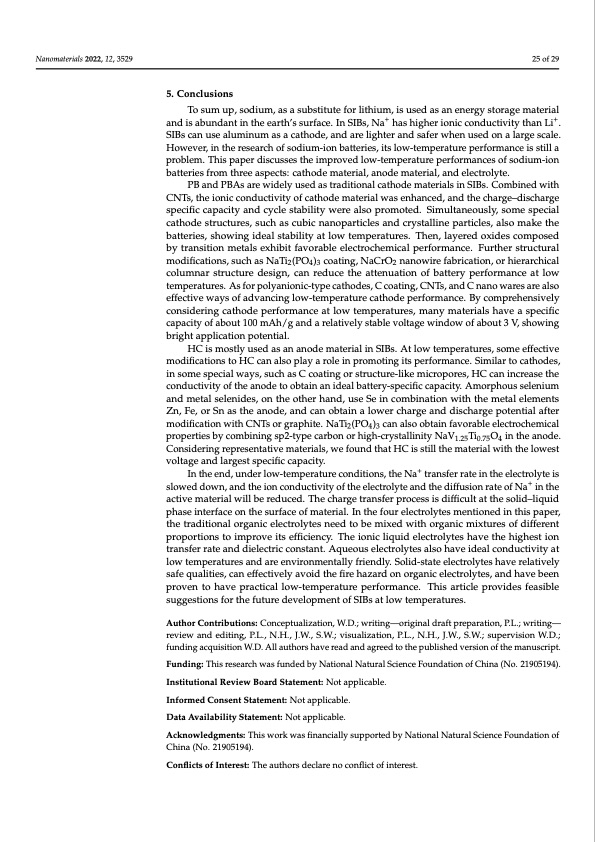
PDF Publication Title:
Text from PDF Page: 025
Nanomaterials 2022, 12, 3529 25 of 29 5. Conclusions To sum up, sodium, as a substitute for lithium, is used as an energy storage material and is abundant in the earth’s surface. In SIBs, Na+ has higher ionic conductivity than Li+. SIBs can use aluminum as a cathode, and are lighter and safer when used on a large scale. However, in the research of sodium-ion batteries, its low-temperature performance is still a problem. This paper discusses the improved low-temperature performances of sodium-ion batteries from three aspects: cathode material, anode material, and electrolyte. PB and PBAs are widely used as traditional cathode materials in SIBs. Combined with CNTs, the ionic conductivity of cathode material was enhanced, and the charge–discharge specific capacity and cycle stability were also promoted. Simultaneously, some special cathode structures, such as cubic nanoparticles and crystalline particles, also make the batteries, showing ideal stability at low temperatures. Then, layered oxides composed by transition metals exhibit favorable electrochemical performance. Further structural modifications, such as NaTi2(PO4)3 coating, NaCrO2 nanowire fabrication, or hierarchical columnar structure design, can reduce the attenuation of battery performance at low temperatures. As for polyanionic-type cathodes, C coating, CNTs, and C nano wares are also effective ways of advancing low-temperature cathode performance. By comprehensively considering cathode performance at low temperatures, many materials have a specific capacity of about 100 mAh/g and a relatively stable voltage window of about 3 V, showing bright application potential. HC is mostly used as an anode material in SIBs. At low temperatures, some effective modifications to HC can also play a role in promoting its performance. Similar to cathodes, in some special ways, such as C coating or structure-like micropores, HC can increase the conductivity of the anode to obtain an ideal battery-specific capacity. Amorphous selenium and metal selenides, on the other hand, use Se in combination with the metal elements Zn, Fe, or Sn as the anode, and can obtain a lower charge and discharge potential after modification with CNTs or graphite. NaTi2(PO4)3 can also obtain favorable electrochemical properties by combining sp2-type carbon or high-crystallinity NaV1.25Ti0.75O4 in the anode. Considering representative materials, we found that HC is still the material with the lowest voltage and largest specific capacity. In the end, under low-temperature conditions, the Na+ transfer rate in the electrolyte is slowed down, and the ion conductivity of the electrolyte and the diffusion rate of Na+ in the active material will be reduced. The charge transfer process is difficult at the solid–liquid phase interface on the surface of material. In the four electrolytes mentioned in this paper, the traditional organic electrolytes need to be mixed with organic mixtures of different proportions to improve its efficiency. The ionic liquid electrolytes have the highest ion transfer rate and dielectric constant. Aqueous electrolytes also have ideal conductivity at low temperatures and are environmentally friendly. Solid-state electrolytes have relatively safe qualities, can effectively avoid the fire hazard on organic electrolytes, and have been proven to have practical low-temperature performance. This article provides feasible suggestions for the future development of SIBs at low temperatures. Author Contributions: Conceptualization, W.D.; writing—original draft preparation, P.L.; writing— review and editing, P.L., N.H., J.W., S.W.; visualization, P.L., N.H., J.W., S.W.; supervision W.D.; funding acquisition W.D. All authors have read and agreed to the published version of the manuscript. Funding: This research was funded by National Natural Science Foundation of China (No. 21905194). Institutional Review Board Statement: Not applicable. Informed Consent Statement: Not applicable. Data Availability Statement: Not applicable. Acknowledgments: This work was financially supported by National Natural Science Foundation of China (No. 21905194). Conflicts of Interest: The authors declare no conflict of interest.PDF Image | Na Ion Batteries Used at Low Temperatures

PDF Search Title:
Na Ion Batteries Used at Low TemperaturesOriginal File Name Searched:
nanomaterials-12-03529-v4.pdfDIY PDF Search: Google It | Yahoo | Bing
Salgenx Redox Flow Battery Technology: Salt water flow battery technology with low cost and great energy density that can be used for power storage and thermal storage. Let us de-risk your production using our license. Our aqueous flow battery is less cost than Tesla Megapack and available faster. Redox flow battery. No membrane needed like with Vanadium, or Bromine. Salgenx flow battery
| CONTACT TEL: 608-238-6001 Email: greg@salgenx.com | RSS | AMP |